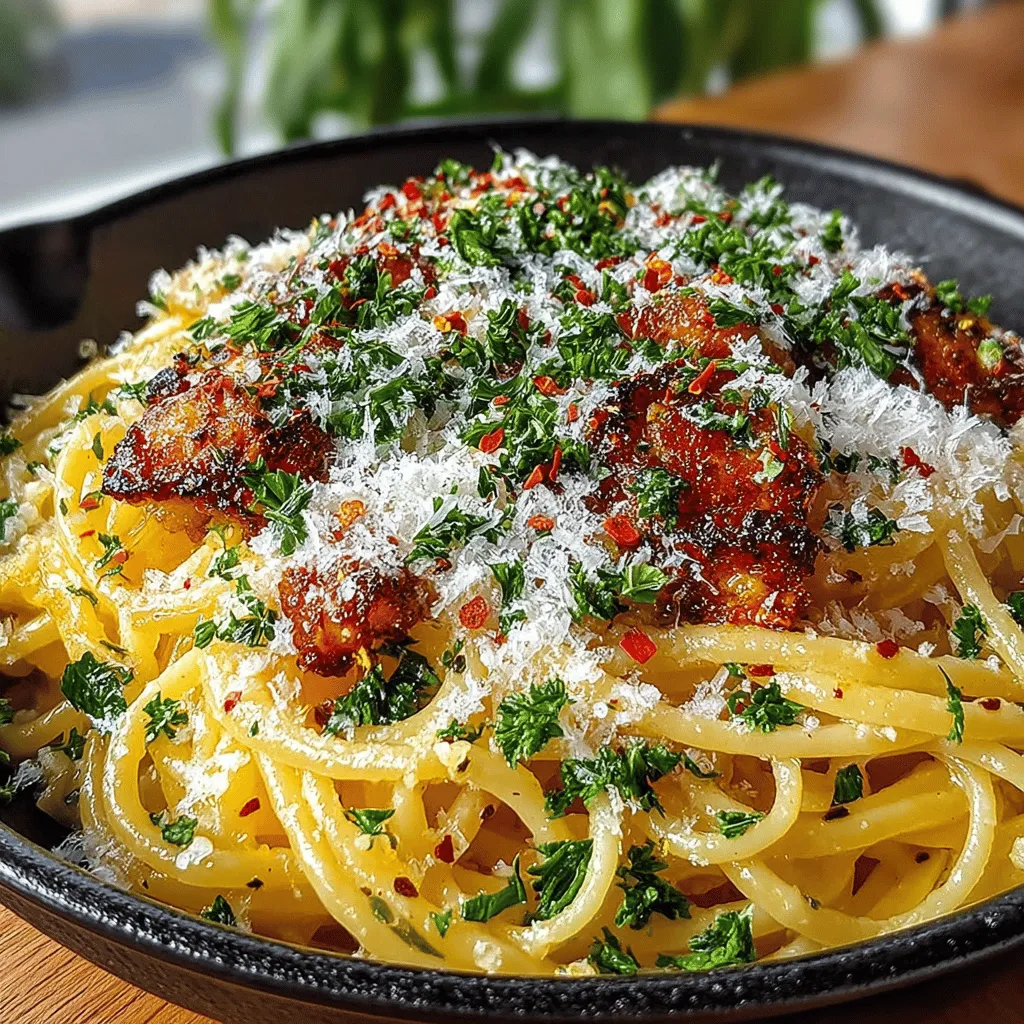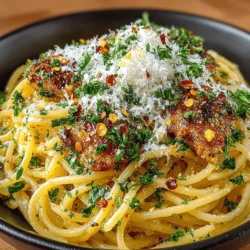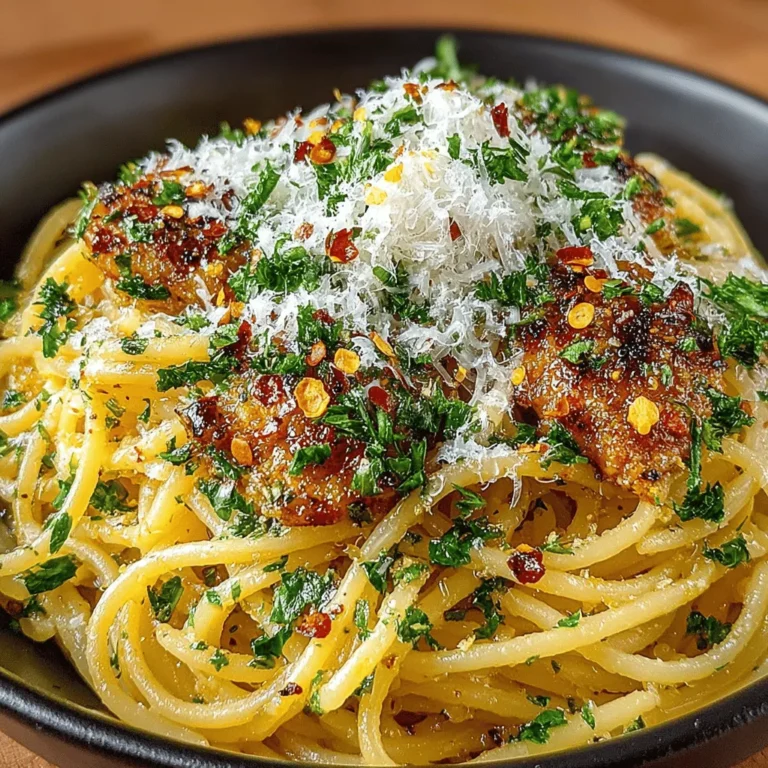Title: Spaghetti Aglio e Olio Magic: A Simple Yet Flavorful Italian Classic
Introduction
Spaghetti Aglio e Olio is a timeless Italian dish that embodies the essence of simplicity and flavor. With just a handful of ingredients—namely garlic, olive oil, red pepper flakes, and parsley—this recipe not only showcases the beauty of cooking with fresh ingredients but also highlights the magic of Italian cuisine. It’s a dish that has transcended its humble origins in the streets of Naples to become a beloved staple in kitchens around the world. In this article, we will delve into the history of Spaghetti Aglio e Olio, examine the key ingredients that contribute to its charm, and provide a step-by-step guide to creating this delicious meal. Whether you’re a seasoned cook or a beginner in the kitchen, you’ll find that this easy recipe is perfect for any occasion.
The History of Spaghetti Aglio e Olio
To truly appreciate Spaghetti Aglio e Olio, it is essential to understand its roots within Italian culinary tradition. This dish hails from the Neapolitan region of Italy, where it was traditionally prepared by the working class who needed a quick, affordable meal that could be made with readily available ingredients. The dish’s name translates to “spaghetti with garlic and oil,” a straightforward description that perfectly captures its essence.
Aglio e Olio’s popularity surged beyond Italy’s borders, especially after World War II, when Italian immigrants brought their culinary traditions to new lands, particularly the United States. As Italian-American cuisine began to flourish, Spaghetti Aglio e Olio became a favorite for its simplicity, allowing home cooks to create a restaurant-quality meal with minimal effort.
The cultural significance of Spaghetti Aglio e Olio is profound; it represents the Italian philosophy of cooking—using quality ingredients, respecting traditions, and celebrating the joy of sharing food with family and friends. Today, it remains a beloved dish in Italian households and is frequently featured on menus worldwide, symbolizing comfort and the beauty of uncomplicated cooking.
Key Ingredients for Spaghetti Aglio e Olio
At the heart of any great dish are its ingredients, and Spaghetti Aglio e Olio is no exception. Each component plays a critical role in creating the dish’s signature flavor, making it essential to choose high-quality products. Here’s a closer look at the key ingredients that make this dish shine:
– Spaghetti: The foundation of this dish is, of course, the spaghetti itself. While any long pasta can be used, traditional spaghetti is preferred for its ability to hold the sauce and flavors effectively. Opt for high-quality durum wheat pasta, as it offers a satisfying texture and is more likely to cook into that perfect al dente consistency.
– Garlic: Garlic is the star ingredient in Spaghetti Aglio e Olio. It infuses the dish with a robust flavor that defines its character. Beyond its culinary appeal, garlic is also celebrated for its health benefits, including its potential to boost the immune system and improve heart health. When preparing this dish, using fresh garlic is crucial; the flavor is far superior to that of pre-minced varieties.
– Extra Virgin Olive Oil: The quality of the olive oil used can make or break this dish. Extra virgin olive oil is preferred for its rich flavor and health benefits, including anti-inflammatory properties and heart-healthy fats. When cooking, be sure to choose a high-quality oil that you enjoy eating, as it will significantly enhance the overall taste of the dish.
– Red Pepper Flakes: These give Spaghetti Aglio e Olio its signature kick. Adjusting the amount of red pepper flakes allows you to control the heat level of the dish, catering to your personal preference. For those who prefer a milder flavor, a smaller amount can be used, while spice lovers can increase the quantity for an extra punch.
– Fresh Parsley: This herb adds a vibrant freshness to the dish, balancing the richness of the olive oil and garlic. Chopped fresh parsley not only enhances the flavor but also provides a pop of color, making the dish visually appealing.
– Optional Ingredients: While the classic recipe is simple, some variations include ingredients like Parmigiano-Reggiano for added creaminess or lemon zest for a citrusy brightness. These additions can elevate the dish while still keeping it true to its roots.
Step-by-Step Guide to Making Spaghetti Aglio e Olio
Now that we’ve explored the dish’s rich history and essential ingredients, let’s dive into the step-by-step process of making Spaghetti Aglio e Olio. This straightforward recipe is perfect for beginners and seasoned cooks alike, allowing for creativity while sticking to tradition.
1. Cooking the Spaghetti: Begin by bringing a large pot of salted water to a boil. The salt is essential, as it not only flavors the pasta but also enhances the overall taste of the dish. Once the water is boiling, add the spaghetti and cook according to the package instructions, typically around 8-10 minutes for al dente texture. To achieve the perfect al dente spaghetti, taste the pasta a minute before the recommended cooking time; it should be firm yet tender.
2. Preparing the Garlic Oil: While the spaghetti is cooking, it’s time to prepare the garlic oil. In a large skillet, pour in a generous amount of extra virgin olive oil, enough to coat the spaghetti once it’s added—about ¼ cup should suffice. Heat the oil over a medium flame, being careful not to let it smoke. Add thinly sliced or minced garlic to the oil. The key to infusing the garlic flavor is to cook it slowly; you want it to turn golden and fragrant but not burnt. Stir frequently, allowing the garlic to infuse the oil while preventing it from becoming overly bitter.
By following these initial steps, you’re laying the groundwork for a delicious Spaghetti Aglio e Olio that highlights the beauty of simplicity in Italian cooking. As you continue through the recipe, you’ll discover how these foundational techniques and ingredients come together to create a dish that is both comforting and sophisticated. Stay tuned for the next part, where we will explore the finishing touches and serve-up tips that will elevate your Spaghetti Aglio e Olio to new heights.

Adding Spice: Enhancing the Dish with Red Pepper Flakes
A key element that elevates Spaghetti Aglio e Olio is the addition of red pepper flakes. This versatile ingredient introduces a delightful heat that perfectly balances the rich flavors of olive oil and garlic. When incorporating red pepper flakes, the amount can be adjusted according to your spice tolerance. Start with a quarter teaspoon if you prefer a milder kick, and gradually increase to half a teaspoon or more for a bolder flavor.
To effectively add the spice, sprinkle the red pepper flakes into the hot olive oil after the garlic has begun to soften but before it turns golden. This allows the oil to absorb the flavor and heat from the flakes, ensuring that each strand of pasta is infused with that wonderful warmth. The combination of garlic and red pepper creates a fragrant aroma that will entice anyone nearby, making it a perfect dish for gatherings or cozy family dinners.
Combining with Pasta: Perfecting the Texture and Flavor Balance
Once your spaghetti is al dente, it’s time to bring all the components together. Before draining the pasta, reserve about a cup of the starchy cooking water. This water is a secret weapon in achieving the perfect texture and flavor balance in your dish. The starch helps bind the sauce to the pasta, creating a creamy, cohesive consistency without the need for heavy cream.
To combine the pasta with the garlic and olive oil mixture, transfer the drained spaghetti directly into the skillet over low heat. Toss the pasta gently to coat it evenly with the oil and garlic. If the pasta seems dry or the sauce needs a little loosening, gradually add the reserved pasta water, one tablespoon at a time, until you reach your desired consistency. This step is crucial; too little water can lead to a dry dish, while too much can create a soupy mess.
Continue tossing until the spaghetti is thoroughly coated and heated through. Taste the dish at this stage to adjust seasoning. You may want to add a pinch of salt or a little more red pepper flakes depending on your preference. This final mixing stage is where the magic happens, allowing the flavors to meld beautifully and ensuring each bite is as flavorful as the last.
Finishing Touches: Incorporating Herbs and Optional Ingredients
To elevate your Spaghetti Aglio e Olio further, consider adding fresh herbs and optional ingredients. Chopped parsley is a classic addition that not only adds a pop of color but also a fresh flavor that brightens the dish. For those who enjoy a hint of citrus, a squeeze of lemon juice or a sprinkle of lemon zest can enhance the overall flavor profile, offering a refreshing contrast to the richness of the olive oil.
If you want to get creative, consider adding grated Parmesan cheese for an extra layer of flavor. While traditional Spaghetti Aglio e Olio is typically served without cheese, the umami richness of Parmesan can complement the dish beautifully. For a vegan option, nutritional yeast can provide a cheesy flavor without the dairy.
Another option is to incorporate toasted pine nuts or walnuts for a crunchy texture that contrasts with the soft pasta. Simply toast the nuts in a dry skillet until golden before adding them to the dish. This addition not only enhances the flavor but also adds a nutritious element to your meal.
Serving Suggestions for Spaghetti Aglio e Olio
Creative Ideas for Presenting and Enjoying This Dish
When it comes to serving Spaghetti Aglio e Olio, presentation can elevate the dining experience. Use a large, shallow serving bowl to showcase the pasta, allowing it to be the star of the table. Twirl the spaghetti using a fork and a spoon to create elegant nests on each plate. Garnish with a sprinkle of extra parsley, a dash of red pepper flakes, or a drizzle of high-quality olive oil for a touch of sophistication.
Plating Techniques for an Elegant Presentation
For a more formal presentation, consider using tongs to serve the pasta in a neat, twirled mound in the center of each plate. This technique not only looks impressive but also makes it easy for guests to enjoy. Add a few extra herbs or a whole garlic clove for garnish, and place a small bowl of freshly grated Parmesan cheese on the side for guests to help themselves.
Pairing with Wines: The Best Options to Complement the Meal
Pairing wine with Spaghetti Aglio e Olio enhances the dining experience. A crisp, dry white wine like Pinot Grigio or Sauvignon Blanc works beautifully, as the acidity of the wine cuts through the richness of the olive oil. If you prefer red wine, a light-bodied Chianti can complement the garlic and spice without overpowering the dish. For a non-alcoholic option, consider sparkling water with a slice of lemon or a refreshing iced tea to balance the flavors.
Side Dishes That Enhance the Dining Experience
To complete your meal, consider serving Spaghetti Aglio e Olio with complementary side dishes. A simple arugula salad dressed with lemon vinaigrette can provide a refreshing contrast to the richness of the pasta. Alternatively, roasted vegetables or a classic Caprese salad can enhance the Italian theme of your dinner. Breadsticks or a crusty loaf of Italian bread are also excellent choices, perfect for soaking up any leftover olive oil.
Nutritional Benefits of Spaghetti Aglio e Olio
The Nutritional Value of Spaghetti and Its Role in a Balanced Diet
Spaghetti, primarily made from durum wheat, serves as a good source of carbohydrates, which are essential for energy. Whole wheat pasta is an excellent choice for added fiber, which aids digestion and helps you feel fuller longer. A typical serving of spaghetti provides essential vitamins and minerals, including B vitamins, iron, and magnesium, making it a nutritious base for any meal.
Health Benefits of Garlic and Olive Oil
Garlic, a star ingredient in Spaghetti Aglio e Olio, is known for its numerous health benefits. It contains allicin, a compound with anti-inflammatory and antioxidant properties. Regular consumption of garlic can help lower blood pressure, improve cholesterol levels, and support the immune system.
Olive oil, particularly extra virgin olive oil, is celebrated for its heart-healthy fats. Rich in monounsaturated fats, antioxidants, and anti-inflammatory compounds, it is a staple in the Mediterranean diet and is associated with numerous health benefits, including reduced risk of chronic diseases and improved brain health.
Balancing Indulgence with Moderation
While Spaghetti Aglio e Olio is a simple and delicious dish, enjoying it in moderation is key to a balanced diet. Incorporating plenty of vegetables, lean proteins, and whole grains can help create a well-rounded meal. By being mindful of portion sizes and complementing the pasta with healthy side dishes, you can savor this traditional Italian recipe without guilt.
Exploring Variations of Spaghetti Aglio e Olio
Adding Protein: Shrimp, Chicken, or Plant-Based Options
To transform your Spaghetti Aglio e Olio into a more substantial meal, consider adding protein. Sautéed shrimp is an excellent choice, as its delicate flavor pairs beautifully with the garlic and olive oil. Simply cook the shrimp in the same skillet after the garlic is fragrant, then toss in the pasta.
For a heartier option, grilled or sautéed chicken breast can be sliced and added to the dish. For those following a plant-based diet, consider adding chickpeas or lentils for a protein boost without meat. These options not only enhance the dish but also contribute additional nutrients.
Vegetable Additions: Broccoli, Spinach, or Cherry Tomatoes
Incorporating vegetables into your Spaghetti Aglio e Olio not only adds color but also boosts the nutritional profile. Broccoli florets can be blanched and added to the pasta during the last minute of cooking for a vibrant, nutritious addition. Fresh spinach can be tossed in just before serving, wilting slightly with the heat of the pasta.
Cherry tomatoes, either roasted or sautéed, add a burst of sweetness that complements the savory flavors of the dish. Simply halve the tomatoes and cook them in the garlic oil until they soften for a delightful addition.
Gluten-Free Alternatives: Using Alternative Pasta Types
For those with gluten sensitivities or celiac disease, gluten-free pasta options have become widely available. Brown rice pasta, quinoa pasta, or chickpea pasta can be excellent alternatives that maintain the essence of Spaghetti Aglio e Olio while catering to dietary needs. Follow the cooking instructions on the package to ensure the pasta reaches the desired texture.
Conclusion
Spaghetti Aglio e Olio is more than just a quick meal; it’s a celebration of Italian tradition and the beauty of simplicity in cooking. By using high-quality ingredients and following a straightforward process, anyone can create a delicious dish that delights the senses. Whether enjoyed on a busy weeknight or served at a dinner party, this recipe reminds us that the best meals often come from the simplest methods. Embrace the magic of Spaghetti Aglio e Olio and savor the flavors of Italy from the comfort of your own home.


